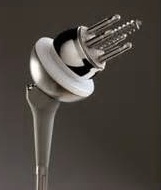 HSS SURGEON: SHOULDER ARTHROPLASTY AND REVERSES ON THE UPTICK (Orthopedics This Week)
HSS SURGEON: SHOULDER ARTHROPLASTY AND REVERSES ON THE UPTICK (Orthopedics This Week)
Shoulder Arthroplasty, Reverse Replacement On the Rise
Within the orthopedic world, shoulders are the superstars these days. According to new research, the use of shoulder arthroplasty is on the rise, as is the changeover to treating many complex fractures with reverse replacements instead of hemiarthroplasty. Edward Craig, M.D., M.P.H. is an attending surgeon at Hospital for Special Surgery (HSS). Dr. Craig, who also holds an appointment with Weill Cornell Medical School, tells OTW, “We are seeing an increase in shoulder arthroplasty relative to other large joints because of better technology, more widespread surgeon education, and more predictable and durable implants. In addition, there is a substantial upsurge in reverse shoulder replacement. We have two publications in the pipeline on the national utilization of reverse shoulder and the national utilization of reverses for fracture of the shoulder versus other types of shoulder replacement.”
“When total shoulder replacement was designed it was done so that it looked like and functioned as a normal shoulder, i.e., with a metal ball resting against a plastic socket. However, while this relieves pain, some patients do not have any healthy soft tissue, specifically the rotator cuff, to facilitate movement. The dilemma was then what to do when someone is in pain and needs a new joint but has no healthy soft tissue to either stabilize or move it.”
Dr. Craig, who has co-designed an anatomic shoulder and a reverse prosthesis, says, “The surgical use of reverse prosthesis seems to be increasing both for arthritis and fractures; in the early years of reverse shoulder arthroplasty the reported complication rate was higher than the anatomic shoulder and thus warranted appropriate caution and careful patient selection. But as surgeons have learned more and as implant technology and instrumentation have improved and become more predictable, the complication rates have fallen. The reverse has not had as long of a track record as the anatomic design, however, so we must continue to monitor it closely for several years.”
“The inherent concept in the reverse prosthesis is one in which the positions of the metal ball and plastic socket are ‘reversed’ and the implant itself had more stability and thus could be utilized in the absence of the stabilizing rotator cuff. The other critical piece was that the rotator cuff was not essential for movement…it’s moved by the deltoid muscle, a muscle which functions well in most people even if this is a non functioning rotator cuff.”
“When we looked at the national use of reverse shoulder arthroplasty, we found that the most recent nationwide inpatient data was from 2011 and that there were 70,000 shoulder arthroplasties in the database. More than a third of shoulder replacements were reverse prostheses. And while the majority of reverse replacements were for arthritis and rotator cuff problems, at this point in the U.S. at least one out of four complex shoulder fractures are treated with a reverse replacement. There has been a big uptick in this because when someone has a complex shoulder fracture, the normal rotator cuff tendon attachments of the bone stay attached to the bone and it is the bone that breaks. In order for the patient to regain function of the arm they must have a healthy rotator cuff attachment to the bone and the bone of the shoulder must heal to the rest of the humerus, which heals as part of the fracture. If it doesn’t heal then the shoulder functions as if there is a deficient rotator cuff, thus compromising both movement and stability.”
“For years, when someone had a complex fracture of the upper humerus involving the ball of the ball/socket joint you needed to put in an artificial ball hemiarthroplasty. We looked at the national utilization of reverse shoulder arthroplasty versus hemiarthroplasty for proximal humerus fractures. We found that there were 8,000 proximal humerus fractures, of which nearly 30% were done with a reverse shoulder prosthesis. And interestingly, if you look at the reverse versus the hemi for fractures, the results are at least as good as hemiarthroplasty results and in some studies are better. Interestingly, the reverse is statistically more likely to be done in small, rural, nonteaching hospitals.”
“The reverse prosthesis is an attempt to make up in prosthetic design for both pathologic joint and soft tissue in a design that doesn’t look like a normal shoulder. It works great, but it doesn’t work like a normal shoulder. The ability to lift the arm is not always predictable with the reverse. And while it has revolutionized how we treat many complication shoulder problems, there remains the fact that it is more expensive than the anatomic design. I do think that over the next five years we’ll see the cost come down.”

 Tiger Buford – retained recruiter dissecting orthopedics
Tiger Buford – retained recruiter dissecting orthopedics